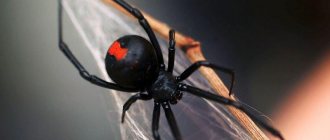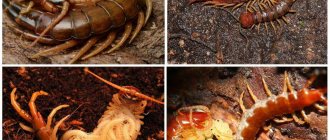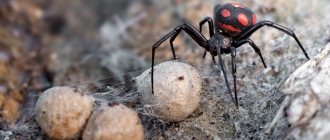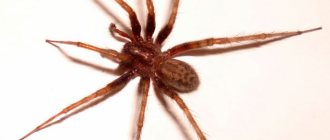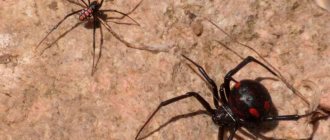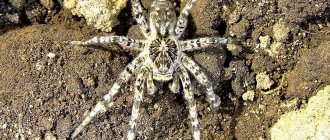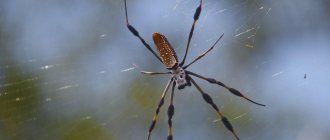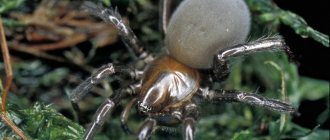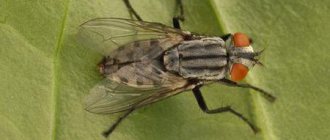- Wild animals
- >>
- Arachnids
The brown recluse spider is very small, but very dangerous - it is so strong that without timely medical attention it can lead to death, while the pain does not begin to be felt immediately, and it can bite a sleeping person. This dangerous creature often lives in abandoned buildings and even residential buildings.
Origin of the species and description
Photo: Brown recluse spider
The appearance of the first arachnids dates back to the Devonian period - however, these were not at all the same species that inhabit our planet now. Arachnids evolve quite quickly, as a result old species die out, but not just like that, but by changing and giving rise to new ones.
The most ancient arachnids became the first sea creatures to reach land, settled on it, and when other living creatures followed them, they began to lead a predatory lifestyle. The main difference from other living creatures was their web, produced by special glands derived from one of the pairs of legs.
It is by the use of the web that it is determined when the ancestors of the spider species originated: the simplest ones use it only to create cocoons, while the more advanced ones find other uses for it - for example, setting up webs or making nests. The brown recluse spider is one of those that uses its web only for its cocoon.
Video: Brown recluse spider
But this does not mean that the species itself is ancient - like all other types of arachnids, it appeared not so long ago, within a few tens of millions of years ago, it just changed relatively little in comparison with its ancient ancestors. In general, the evolution of spiders has been relatively little studied and further research is necessary.
Scientists have not yet reliably established the chain along which most of them, including hermit spiders, developed. It is only clear that the lifestyle of the brown recluse spider is similar to that led by its distant ancestors - it is even possible that it needed such a strong poison against some already extinct creatures, and therefore has survived to this day. This species was described in 1940 by V. Gerch and S. Mulaik. Received the scientific name Loxosceles reclusa and belongs to the family Sicariidae.
Black Widow
The most “rustic” species of spiders for hunting
Ask any person what poisonous spider they know and you will probably hear - a black widow. It is found everywhere in shady spots around the world. This is especially true for females: they are one and a half times larger than males (body length is about three centimeters). Their body is shaped like an hourglass, and there is even a red hourglass pattern on the lower part of their abdomen. Black widows get their name because the females eat the males after mating. Did you think only praying mantises do this?
According to a study by National Geographic magazine, black widow venom is 15 times stronger than that of a rattlesnake, so a bite can cause extremely unpleasant consequences. First, the person feels a sharp pain in the area of the bite. This area quickly turns red and swells. After 15 minutes the pain spreads in waves throughout the body. Cramps begin, especially strong in the front of the torso. This can lead to panic, severe shortness of breath and even suffocation.
For adults, a black widow bite is rarely fatal - only 1% of victims die. However, the venom of this species is extremely toxic to people with weakened immune systems, the elderly and children.
Appearance and features
Photo: Poisonous brown recluse spider
The dimensions of this spider are quite small: with legs up to 20 mm, and without them even 5-7 mm. Usually the female is larger, but the difference is small. The body of the spider is covered with hairs, thick and short, in appearance they can be mistaken for fur.
It also differs from most other spiders in that it has only 6 eyes, not 8. It can be recognized by this feature: it is clearly visible that the brown recluse spider has only one pair of eyes in the middle, and two more on the sides of it . Otherwise, it differs little from some other spiders, which is why they are often confused.
However, there is another important sign: on its cephalothorax you can see a pattern reminiscent of a violin. However, this drawing still needs to be examined; this often requires a magnifying glass. Although these spiders are called brown, in reality not all of them are like that, some are gray or dark yellow.
Their web does not have a clear and orderly pattern, and seems to be woven completely chaotically - in essence, this is how it is. The web is sticky to the touch. The paws are thin and long. An alarmed recluse spider pulls the front pair into itself, leans on the back one and lifts the middle one up. This is how he warns that he is ready to defend himself; this pose is designed to scare away the aggressor.
Interesting fact: It was previously believed that giant spiders lived on Earth in ancient times, but relatively recently it turned out that an error was made during the reconstruction of the fossils, and in fact they are not at all that large. So the largest spider that lives on our planet to this day is the goliath tarantula, its length is 28 centimeters.
Karakurt
This spider is another representative of the black widow genus. Their distribution area is very vast; they can be found on all continents except Antarctica and the Arctic. Although the size of the karakurt is small - only 2-3 cm, it poses a mortal danger to humans. But only females are poisonous, and they attack only if they feel their life is threatened.
Bright red spots on the black body distinguish this spider from its relatives, but with age it can completely turn black. Karakurts settle mainly in dry places: on abandoned arable lands, near ravines. Sometimes they can visit people, crawling into houses, barns, garages and so on.
The bite of this species of black widows itself is not painful. But after a short time, when the poison begins to act, a person experiences severe poisoning. The place of the bite, and then the whole body, is pierced by a sharp pain, panic appears, it becomes difficult to breathe, and so on. A person is not in danger of instant death, but there is no need to delay in providing assistance.
Where does the brown recluse spider live?
Photo: Brown recluse spider in Turkey
The main habitat is the southeastern United States from Illinois and Nebraska to Texas and Virginia. In California it can be found occasionally and only indoors. In the states located within the specified range it is found quite often.
In some places, even too often - sometimes real invasions of these spiders occur. They can also be found outside the designated range, but much less often, only if they are accidentally introduced. It is capable of living in various natural conditions, so even if during transportation it ends up in very distant lands, for example, in Europe, it successfully survives.
There is evidence that it has taken root in Africa and South America. In addition, in recent years it has been noticed quite often in Australia, and it is possible that it has gained a foothold on this continent. Although the habitat of these spiders outside of North America has not yet been reliably established, information about them is fragmentary.
It prefers indoors as a habitat, best if it is warm and dry. At the same time, he was called a hermit for a reason, but because he does not like company and prefers to live in abandoned or simply uninhabited premises, such as summer houses, basements or attics.
It will not be an obstacle even if the room is unheated: the hermit spider is quite capable of surviving the very moderate winter cold inherent in its habitat. And yet it does not like the cold, and therefore in winter it can also move into living spaces through doors or windows.
He prefers to hide from people and live in secluded places: behind baseboards, furniture, radiators. It can also live away from dwellings, in various shelters, for example, in a rock or under logs.
Now you know where the brown recluse spider lives. Let's see what it is.
Habitat
The largest concentrations of the recluse spider are observed in the eastern regions of the United States. From Colorado, California and New Mexico, the predator migrates south of the mainland. It can sometimes be seen in Australia. The spider is also found in the Mediterranean and subtropical zones of Eurasia, but only with rare exceptions and rather as a guest, brought along with cargo by air or across the ocean.
Predators build their nests under dry logs, in rock crevices or in woody debris. Hermits are resistant to sudden climatic changes and endure unfavorable winter conditions. They can live in unheated basements or attics. The predator can go without food and water for several months.
What does the brown recluse spider eat?
Photo: Brown recluse spider
He hunts exclusively for small insects that are smaller in size than himself, most often significantly. This is due to the fact that he does not set up trapping nets, but hunts without them: he tracks prey, after which he attacks it and bites it, injecting poison. Without the help of the network, it is difficult for him to cope with large prey - it can be dangerous. In his diet:
- small midges;
- mosquitoes;
- mole;
- small spiders, including fellow spiders;
- and similar living creatures.
After a bite, the victim is immediately paralyzed, and she can no longer resist - and most often dies in a matter of moments, since the venom of this spider is very strong. This method of hunting is still less effective than using a net, and therefore the recluse spider sometimes has to remain without food for a very long time.
His body is accustomed to this situation - it can store nutrients for future use for several weeks or even a month and a half in advance. It hunts at night and usually rests in secluded places during the day - it does not like sunlight at all and tries to avoid it.
Interesting fact: Typically, spider venom is poisonous to the extent necessary for food. So, if a spider feeds on insects the size of a fly, it is just enough to quickly immobilize it. The larger the prey the spider hunts, the stronger its venom.
But with this species everything is completely different: it hunts very small animals, but its venom is extremely toxic even to people - and they are not afraid of the venom of almost any other spider. It remains a mystery to researchers why, during the course of evolution, it began to produce such a powerful poison.
Habitat
The largest concentrations of the recluse spider are observed in the eastern regions of the United States. From Colorado, California and New Mexico, the predator migrates south of the mainland. It can sometimes be seen in Australia. The spider is also found in the Mediterranean and subtropical zones of Eurasia, but only with rare exceptions and rather as a guest, brought along with cargo by air or across the ocean.
Predators build their nests under dry logs, in rock crevices or in woody debris. Hermits are resistant to sudden climatic changes and endure unfavorable winter conditions. They can live in unheated basements or attics. The predator can go without food and water for several months.
Features of character and lifestyle
Photo: Brown recluse spider in Russia
He always tries to live alone so as not to be disturbed. This means that even if he has settled in an apartment, he cannot be found somewhere in a visible place, except perhaps during a hunt. During its course, it can move far away from the nest, especially if it lives not indoors, but outdoors.
If there is little prey in the place where it lives, it may even move to another. But long walks while hunting are characteristic primarily of males; they move more often, but females are much less easy-going and spend almost all their time in the nest, trying not to move away from it.
Since he prefers to hide from people and is active at night, you can usually meet him at night when he hunts - most often spiders bite people precisely because they disturb them without noticing them in the dark. A spider can be found in a shoe box or in a closet, and sometimes hunting can even lead it into bed.
If they do not encounter people, then by the standards of spiders they live quite a long time - on average 3-4 years, sometimes they can even reach the age of 6 years. During this time, the female manages to lay eggs many times, so if you leave the recluse spider alone, at some point you may find that there is already a whole family of them - so it is better to fight them right away, without waiting until there are a lot of them.
Consequences of a bite
Those who are unlucky describe the bite of a recluse spider as a sharp, sudden sting, the pain of which quickly subsides. At first glance, it can easily be confused with a mosquito bite. It is rare that the victim immediately seeks help, since the consequences occur only after 6–8 hours. What symptoms appear?
- Initially painless, after a few hours the bite begins to pulsate with acute pain.
- The damaged area swells, turns red, and becomes hot.
- Gradually, the redness and swelling intensify and spread - this is the lesion growing under the influence of the toxin.
- The head begins to hurt, weakness, nausea appear, the temperature may rise - symptoms of intoxication of the body.
- A blister appears at the site of skin punctures, which then bursts, forming an ulcer.
It is at this stage that victims usually seek medical help. If it is provided late, local necrosis (death) of tissue may occur. The site of the bite changes radically, turning into a wound, after two days.
Note! Necrosis is a severe, ugly-looking wound when, under the influence of poison, the flesh actually rots away. More precisely, the poison provokes a secondary infection, multiple inflammations that disable the vital systems of the body. Treatment of such complications after a recluse spider bite takes from 3–6 months to 3 years. A noticeable scar remains at the site of the injury.
According to doctors, this poison is so strong that death does not occur just because of a tiny dose of the toxin. But if it gets into the body of an allergy sufferer, a child, or a person with a weak immune system, the outcome is unpredictable.
Urgent Care
What to do if you are bitten by a brown or any other poisonous spider?
- The wound should be washed with soap and cold water and disinfected with an antiseptic.
- Try to squeeze out the poison from the skin puncture.
- To slow the spread of the toxin, apply ice to the bite from time to time.
- It is recommended to apply a tight bandage or tourniquet above the affected area.
- You can take an antibiotic or drink an antiallergic drug.
These are only emergency measures that do not cancel a visit to the doctor. At least for insurance purposes.
Social structure and reproduction
Photo: Poisonous brown recluse spider
They almost always live alone, however, the possibility of forming groups is not excluded. The reasons why these spiders, which usually avoid the company of their relatives, sometimes begin to live in groups, and large ones, have not yet been reliably established.
But one can only feel sorry for the owners of the premises in which such a group settled: it will be very difficult and dangerous to fight them, there are known cases of real invasions, and for the owners they sometimes ended very sadly, because these spiders are extremely poisonous.
At the same time, they are usually not inclined to attack people, or indeed any creatures other than prey: they bite only if they believe that they are being attacked. The problem here is that due to the spider's small size, people sometimes simply don't notice it - and also because encounters often take place in the dark.
For example, a spider may consider it an attack if its limb is accidentally crushed. In addition, females can be very aggressive if a person is close to their nest with clutches - they can bite even if he does not take any aggressive actions.
Reproduction can occur several times a year - after fertilization, the female lays several dozen, sometimes up to fifty, eggs in the cocoon. After this, it remains nearby all the time and guards the clutch, even practically stops hunting. After hatching, the spiderlings grow quickly at first, and after about a month they begin to live separately. They reach sexual maturity at about one year of age.
Life cycle
Immediately after mating, the female begins to prepare a special bed for laying silk in the nest. Afterwards, she covers the eggs with a dense and waterproof cocoon, which looks more like an oval sac 7-8 mm long.
Each clutch contains about 40-50 eggs. As the young grow older, they go through several stages of molting, increasing in size and changing their chitinous cover to a new one. The female takes care of her offspring to the last and does not leave the nest even in the face of a direct threat to her life.
Hermits are considered long-lived among other arthropods. Spiders live on average from 2 to 4 years, but in extremely favorable conditions they can live up to 6 years.
Natural enemies of recluse spiders
Photo: Dangerous brown recluse spider
Although this is a very poisonous and dangerous predator, there are also larger, more dexterous opponents who are not afraid of its poison and feed on it.
These include:
- centipedes;
- crickets;
- geckos;
- wolf spiders;
- and some others.
When living in nature, it faces many dangers, which is why, despite effective reproduction, the population of cinnamon recluse spiders remains quite stable - a very large number of them are exterminated by predators.
This especially applies to young spiders; it is much easier for predators to hunt them than adult recluse spiders that have already gained experience, learned to hide and defend themselves, and have become very dangerous. After all, an unsuccessful hunt for such a poisonous spider can end in the death of the hunter himself!
But in apartments there are much fewer threats for them, because these spiders can multiply quickly in them. Other spiders become their most terrible enemy, because although the recluse spider is dangerous for humans, by the standards of many other spiders it is relatively small in size and inferior in dexterity and strength.
Therefore, the presence of harmless spiders in your home can be useful. For example, haymakers are very effective against hermits and are completely harmless to humans. Also among the enemies of the brown recluse spider, naturally, are people themselves.
Since they are very dangerous, they are often deliberately combated by using toxic substances to remove them from homes or business premises. Removing them from homes in the US states included in the range of these spiders is one of the main activities of pest control specialists.
Latrodectus geometricus
Latrodectus geometricus, better known as the brown widow, is a species of spider found in many areas of South Africa, as well as in the United States, Australia, Afghanistan, China, Japan, Tanzania, Dominican Republic, Cyprus, Costa Rica, El Salvador, Brazil, United Arab Republics Emirates, Pakistan and Thailand. This species is often called the black widow's "cousin" (second on the list). The body length of females varies from 12 to 16 millimeters, males are much smaller - 6–8 mm, but they have longer legs. Typically, Latrodectus geometricus spiders are light brown in color and have a bright orange or yellow hourglass marking on the underside of their abdomen. Males are harmless, only females bite. The poison is relatively harmless to humans.
8
Precautions[11]
To avoid a spider bite, you should
- thoroughly shake out clothes and shoes before using them;
- check bedding and toilet before use;
- wear gloves when carrying firewood, timber and stones (you should check the gloves themselves before doing this);
- remove boxes from under beds; move the beds themselves away from the walls;
- be careful with boxes - spiders often hide in them;
To limit spider access to your home, you should:
- install a protective screen on windows and doors;
- install door sweeps;
- seal cracks and crevices through which spiders can enter the house;
- install a yellow or sodium gas-discharge lamp on the outside of the house - such lamps do not attract insects that the spider feeds on;
- seal the edges of cardboard boxes to prevent spiders from getting into them;
- Use sealed plastic containers to store things in the garage, basement and attic;
Sanitation
- promptly get rid of garbage, old boxes and clothes, piles of stones and other unnecessary things;
- clean out the toilet, basement, garage, attic and outbuildings;
- do not stack timber in front of the house;
- prevent the presence of dead insects in the house that the spider feeds on;
Other measures
- use duct tape to catch spiders;
- thoroughly dust and vacuum the premises to remove spiders, cobwebs and spider eggs (the contents of the dust container should be thrown into a trash container outside the home);
- to kill individual individuals, use a rolled-up newspaper or fly swatter;
Insecticides
There are many pesticides available to control spiders. Some are intended for home use, while others are for licensed use only. If you find a brown recluse spider in your home, it would be wise to contact the services of a professional pest control company.
Research shows that recently developed pyrethroids (eg cyfluthrin, cypermethrin, etc.) are somewhat effective against the brown recluse spider. Wettable powders and microencapsulated "slow-release" formulas provide long-lasting activity and are preferred for use as emulsion sprays
Insecticide treatments should be carried out so that the chemical comes into contact with as many spiders and their webs as possible. Aerosols should be applied to the exterior perimeter of the home (including under eaves, patios, and boards; behind window shutters), baseboards, corners, and other areas where the spider is likely to take up residence. Powders should be applied to crevices and other hard-to-reach places where spiders might be hiding. Aerosol agents such as pyrethrin, while not very effective on their own, can still cause the spider to stay closer to the treated surface.
Folk remedies
Folk remedies are used as an alternative to chemicals. But here you need to understand that the effectiveness of such methods is an order of magnitude lower. This effect can be called rather preventive. But unlike aggressive chemistry, folk remedies are completely safe for humans.
Citrus fruits have proven themselves to be excellent in the fight against spiders. It is enough to place orange or lemon peels in the corners, next to the beds and places where cobwebs accumulate, and spiders will avoid them. You can also use eucalyptus and tea tree essential oils placed around the house in saucers.
Both fresh and dried peppermint help a lot. Spiders do not tolerate the smell of hazelnuts and horse chestnut fruits. When wiping floors, you can add vinegar to the soap solution. The pungent smell will repel not only arthropod predators, but also flies, ants and other harmful insects.
